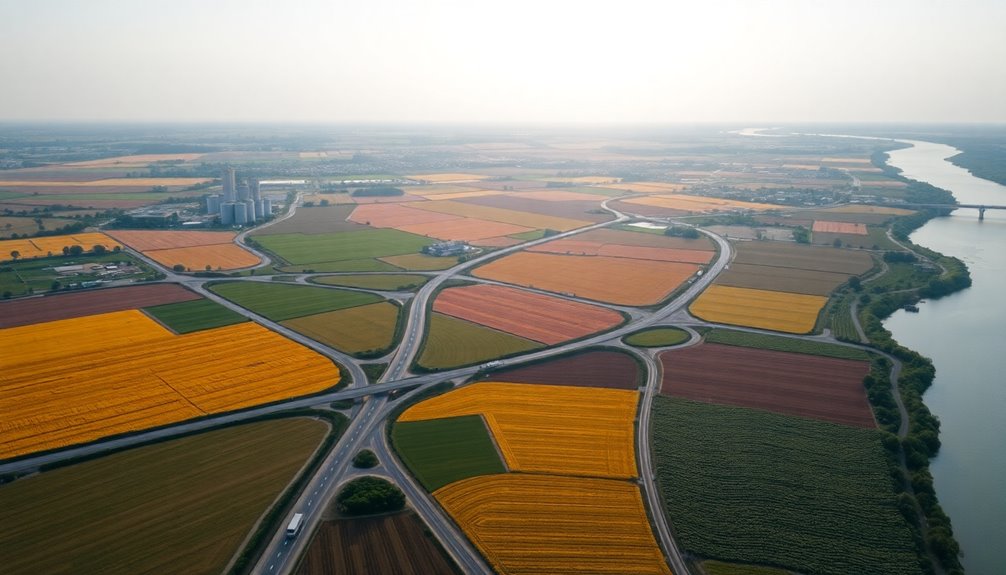The global crop trade has a diverse environmental footprint, heavily impacting carbon emissions, biodiversity, and water resources. Farming accounts for about 40% of land use and 70% of freshwater consumption, leading to pollution and habitat loss. Different countries have varying carbon footprints based on agricultural practices, while synthetic fertilizers exacerbate emissions. Sustainable practices and efficient resource management can help reduce these impacts. Discover how these factors combine to shape our planet's future and what solutions are emerging.
Key Takeaways
- Global crop trade significantly contributes to greenhouse gas emissions, particularly through the use of synthetic fertilizers and inefficient farming practices.
- The carbon footprint of crops varies by country, influenced by agricultural methods, with the U.S. generally having lower emissions for major crops.
- Agricultural expansion for crop production leads to habitat destruction, resulting in substantial biodiversity loss and disrupting ecosystems.
- Efficient water resource management is critical, as agriculture consumes about 70% of global freshwater, impacting sustainability and productivity.
- Pollution from agricultural runoff and chemical use poses serious environmental challenges, necessitating integrated pest management and sustainable waste practices.

As global demand for food continues to rise, understanding the environmental footprint of crop trade becomes crucial for sustainable development. Agriculture occupies about 40% of our planet's land and uses around 70% of freshwater resources, which significantly impacts ecosystems. The sector's expansion is a leading cause of deforestation and habitat loss, as natural landscapes are converted into farmland.
You'll find that agricultural activities also generate substantial greenhouse gas emissions, mainly methane and nitrous oxide. Crop burning and dust contribute to global air pollution, further complicating our environmental challenges.
When it comes to the carbon footprint of trade, concentrating crop production in optimal locations can decrease emissions by up to 71%. However, different countries have varying carbon footprints due to factors like fertilizer use and farming practices. For instance, the U.S. generally produces major crops with a lower carbon footprint compared to other exporters, while synthetic fertilizers, especially in wheat production, significantly heighten emissions. Stricter monitoring of pesticide and antimicrobial residues in agricultural exports will be essential to ensure compliance with emerging sustainability standards.
Land-use changes in nations with lower crop yields can exacerbate this issue.
The impact on biodiversity is another critical concern. Agricultural expansion often leads to substantial biodiversity loss, as natural habitats are transformed into farmland. However, you can reduce the biodiversity footprint by up to 87% through strategic production placement. This habitat destruction disrupts species migration and affects ecosystem health, making sustainable agricultural practices vital for preserving biodiversity.
Agricultural expansion threatens biodiversity, but strategic production can significantly mitigate habitat loss and its effects on ecosystems.
Water resource usage is also a pressing issue. Agriculture accounts for about 70% of global freshwater consumption, and efficient irrigation systems can greatly reduce water usage. Water scarcity threatens agricultural productivity in many regions, highlighting the need for sustainable water management practices.
Finally, pollution and waste generation in agriculture pose significant challenges. Agricultural runoff contributes to water pollution, while chemical pesticides and fertilizers can degrade soil and air quality. Implementing integrated pest management and sustainable waste practices are essential steps toward reducing pollution and promoting a healthier environment.
Frequently Asked Questions
How Do Climate Change Policies Affect Global Crop Trade?
Climate change policies significantly shape global crop trade. By promoting climate-smart practices and supporting resilient crop varieties, you can enhance agricultural productivity and stability.
These policies also encourage trade diversification, allowing you to access a broader range of crops. However, as extreme weather events disrupt trade routes, you'll need to invest in resilient infrastructure.
Ultimately, adapting to climate change through trade ensures food security while addressing environmental impacts in your agricultural systems.
What Are the Economic Impacts of Crop Trade on Local Farmers?
Crop trade can significantly boost your income as a local farmer by expanding market access and increasing demand for your products.
When you sell directly at farmers' markets, you keep more money within your community, stimulating local economic activity and job creation.
Moreover, selling locally often means you're generating more jobs per dollar compared to larger commercial sales, contributing to both economic stability and community growth.
Supporting local agriculture benefits everyone involved.
How Is Technology Changing Crop Trade Sustainability?
Technology's changing the game in crop trade sustainability, and you're in for a treat!
With precision agriculture, you're reducing waste and increasing yields. Real-time data helps you catch issues early, while advanced irrigation conserves water.
Plus, using AI and IoT means smarter farming decisions. By embracing these innovations, you're not just boosting profits; you're also playing a vital role in preserving the environment for future generations.
It's a win-win!
What Role Do Consumers Play in Influencing Crop Trade Practices?
You play a crucial role in influencing crop trade practices with your choices.
By opting for organic, local, or fair trade products, you support sustainable farming and promote ethical labor conditions.
Your demand for transparency in supply chains encourages brands to adopt better practices.
When you advocate for sustainable policies or share information through social media, you amplify the call for change, shaping market dynamics and driving innovation in agricultural methods.
Are There Ethical Concerns Regarding Labor in Global Crop Trade?
When it comes to global crop trade, you might feel like you're walking a tightrope, balancing ethical concerns and consumer choices.
There are serious issues surrounding exploitative labor practices, child labor, and gender discrimination. Many workers endure long hours for meager pay, lacking basic rights.
Conclusion
So, next time you savor that exotic avocado or indulge in a quinoa salad, remember: each bite's a passport stamp for Mother Nature's not-so-happy journey. Who knew your lunch could have such a dramatic backstory? It's not just food; it's an environmental soap opera! Sure, let's keep trading crops across continents, because nothing says sustainability like shipping your dinner halfway around the world. Just don't be surprised when the planet starts charging for excess baggage!









